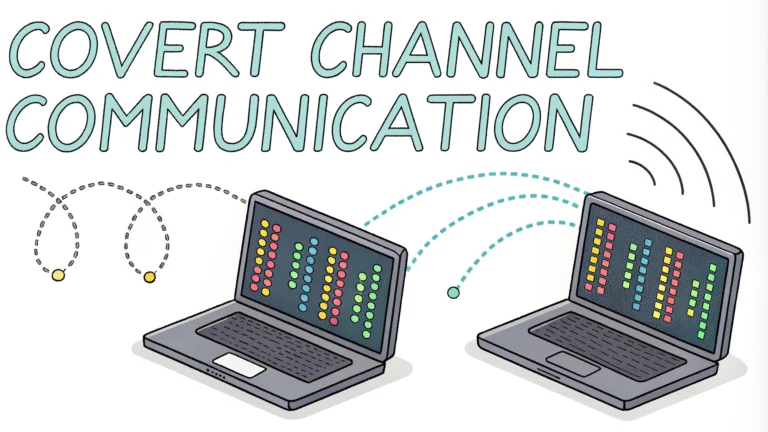Covert channel communication represents a method used in cybersecurity testing to transmit information by exploiting unexpected or unintended communication paths.
Security professionals and penetration testers utilize covert channels to assess system vulnerabilities and identify potential data exfiltration risks.
This guide examines common covert channel techniques, detection methods, and practical implementation strategies for security testing purposes.
Types of Covert Channels
- Storage Channels: Use shared system resources to transfer data
- Timing Channels: Manipulate system timing to encode information
- Network Channels: Exploit network protocols for hidden communication
Common Implementation Methods
DNS tunneling enables data transfer through DNS queries and responses, making it difficult to detect within normal network traffic.
ICMP tunneling utilizes ping requests and responses to establish covert communication channels.
TCP/IP header manipulation allows information hiding within unused protocol fields.
Detection and Prevention Techniques
- Network traffic analysis tools
- Pattern recognition systems
- Statistical anomaly detection
- Protocol verification checks
Practical Testing Tools
| Tool Name | Purpose |
|---|---|
| ptunnel | ICMP tunneling implementation |
| iodine | DNS tunneling toolkit |
| Covert_TCP | TCP header manipulation |
Risk Assessment Guidelines
- Monitor network baseline behavior
- Document all testing procedures
- Obtain proper authorization before testing
- Maintain detailed logs of all covert channel activities
Implementation Best Practices
Always conduct testing within isolated environments to prevent unintended system impacts.
Use dedicated testing networks separate from production systems.
Implement proper access controls and documentation procedures throughout the testing process.
Legal and Ethical Considerations
- Obtain written permission before testing
- Follow responsible disclosure protocols
- Comply with local cybersecurity regulations
- Document all testing activities thoroughly
Moving Forward with Secure Testing
Regular covert channel testing helps organizations identify and address potential security vulnerabilities before they can be exploited.
Contact your organization’s security team or a qualified penetration testing firm to develop a structured testing program.
For more information on professional penetration testing services, reach out to recognized security certification bodies like CREST (www.crest-approved.org) or SANS Institute (www.sans.org).
Advanced Detection Strategies
Network behavior analysis and machine learning algorithms provide enhanced capabilities for identifying sophisticated covert channels.
Automated Monitoring
- Real-time traffic inspection
- Behavioral analysis systems
- ML-based anomaly detection
- Automated response protocols
Mitigation Strategies
Implementing comprehensive security controls helps prevent unauthorized covert channel exploitation.
- Network segmentation
- Protocol restriction policies
- Deep packet inspection
- Egress filtering
Documentation Requirements
| Component | Required Documentation |
|---|---|
| Test Plan | Scope, methodology, timeline |
| Results | Findings, vulnerabilities, metrics |
| Remediation | Recommendations, action items |
Securing Communication Channels
Regular security assessments and updates maintain the integrity of legitimate communication paths while detecting potential covert channels.
Organizations should implement comprehensive monitoring solutions and maintain current security protocols to protect against emerging covert channel techniques.
Establish clear policies for testing procedures and maintain regular training programs for security personnel responsible for detection and prevention.
FAQs
- What is a covert channel in cybersecurity?
A covert channel is a method of communication that allows information to be transferred between systems or processes in a way that violates security policies, often exploiting legitimate communication channels in unexpected ways. - What are the main types of covert channels?
The main types are storage covert channels (hiding data in unused fields or resources), timing covert channels (encoding information through timing of events), and behavioral covert channels (using system behaviors to transmit data). - How does DNS tunneling work as a covert channel?
DNS tunneling encapsulates other protocols or data within DNS queries and responses, exploiting the fact that DNS traffic is often allowed through firewalls, enabling data exfiltration through DNS requests. - What is TCP/IP covert channeling?
TCP/IP covert channeling involves hiding data within unused or optional fields of TCP/IP packet headers, such as the IP identification field or TCP sequence numbers. - How can steganography be used in covert channel communications?
Steganography in covert channels involves hiding data within legitimate files or network traffic, such as embedding information in image pixels or audio files without visible alterations. - What are common indicators of covert channel activity?
Common indicators include unusual DNS traffic patterns, unexpected network protocols, irregular timing patterns in network communications, and anomalous file modifications. - How can ICMP be exploited for covert communications?
ICMP packets can be manipulated to carry hidden data in their payload fields, as ICMP echo requests and replies are often allowed through network security controls. - What tools are commonly used to detect covert channels?
Network monitoring tools like Wireshark, intrusion detection systems (IDS), and specialized covert channel detection software that analyze traffic patterns and packet contents. - How can HTTP/HTTPS be used for covert channel communication?
Data can be hidden within HTTP headers, cookies, or encoded within legitimate web traffic, utilizing standard web protocols to bypass security controls. - What are timing-based covert channels?
Timing-based channels transmit information by manipulating the timing between network events or processes, such as deliberate delays between packets or CPU usage patterns.







